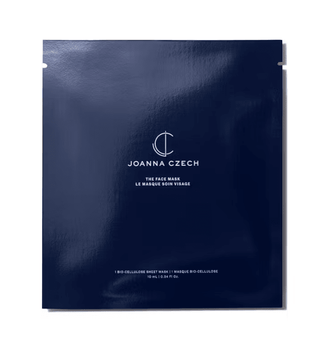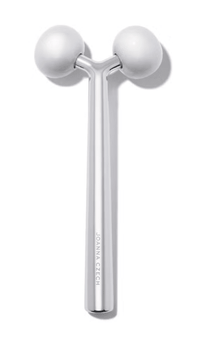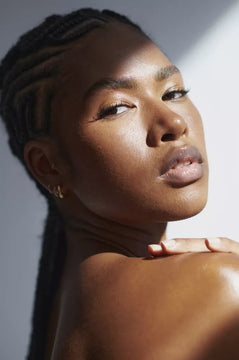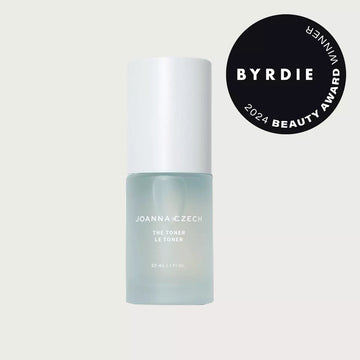Why Are People Paying Good Money to Get “Slapped”?

For looks, of course. Here’s how high-speed facial massages create more defined cheekbones, a healthy glow, and even a deeper sense of calm.
I'm lying on—or, rather, in—the cradle-like treatment bed of world-famous facialist Joanna Czech at her studio in New York City’s SoHo. The experience is famed for good reason. To begin with, the bed is made by Hästens, the luxury sleep brand known for its five- to six-figure mattresses, and its cloudlike loft feels like it was made for royalty. Indeed, modern royalty like Amber Valletta, Michelle Williams, Jennifer Aniston, and Kate Winslet are all among Czech’s famous clients.
Czech’s strong, deft hands lend a near opposite sensation as she begins to cleanse and massage my face. She moves my facial skin and muscle up, up, up, lifting in rapid motions from my jawline to my temples with increasing speed. What begins as a light feathering, almost like the playing of piano keys, accelerates into a rhythm so fast and powerful that I begin to wonder if this legendary aesthetician was born with an extra set of hands I didn’t see when I walked in.
People often describe this rigorous movement as slapping, so I ask her, as she swiftly pummels my face, if that is accurate. “It’s really more like tapping,” Czech tells me. “Slapping would cause friction, which can do more damage than good. The technique I use trespasses beneath the skin down to the muscle so you benefit both organs at the same time. It should never be painful.” (Her clients pay top dollar for the experience; a treatment with Czech will run you at least $1,250.)
“The term for this quick-paced, rhythmic finger slap is tapotement, and it’s been used in Europe and Asia for centuries,” says Lord Gavin McLeod-Valentine, the L.A. facialist to Zoe Saldana, Jessica Chastain, and Laura Dern, among others. “I also do kobido, a similar Japanese methodology that works on the muscle under the cheek to lift.”
How “slapping” works like a temporary facelift
While these aggressive-looking massage techniques make for highly watchable videos on social media that even celebrities can’t resist posting, the pros are adamant that their efforts are not for clicks and views. They spend years fine-tuning their techniques, and they say the benefits include tension release, ingredient absorption, increased blood flow, muscle toning, and skin tightening. Dermatologist Dendy Engleman, MD, concurs. “Proper facial massage can increase oxygenation and circulation, which can also stimulate collagen production,” she says. “This can help to increase the skin’s rosiness and plumpness, and reduce the appearance of lines and wrinkles.”
“This type of massage is a really important part of how I do lifting and sculpting,” says facialist Pietro Simone. “When the muscles get that reverberation, they reach a higher temperature, there’s higher blood flow, and then more oxygen and nutrients.” Simone is also known to treat inside the mouth as well, using intraoral massage to boost muscle stimulation. As someone with TMJ and perpetual puffiness, I love these facials. I find my jaw softened, my newly excavated cheekbones sky-high, and my skin tone surprisingly even post-treatment—no giant flush of redness I would have expected, especially on my pale complexion. This, I’m told, is where money talks. While an untrained eye might see random slapping that anyone could just do to themselves, elite practitioners have perfected the finest sleights of hand to elicit benefits without irritation.
Can you DIY this technique?
I’d like to think so. Many friends have witnessed, with wide-eyed amusement, my self-slapping during event prep or the morning after a well-served party. One friend’s husband told me, kindly, that I looked like a squirrel digging in the soil. Truthfully, I did not find this discouraging—that’s how much I believe in the cause.
But the pros have caveats. “It’s about the angle and directions of the fingers on the face, and the order of the steps,” emphasizes Simone. “If you’re doing it the wrong way and too aggressively, you can actually cause bruising.” There’s also a school of facialists who don’t practice this technique and discourage it for people who have reactive, acne-prone, and inflammatory skin types, arguing that all that touching could irritate sensitive skin and spread acne-causing bacteria.
Not surprisingly, Czech gives it to me straight: “I’ll tell you, this is very hard to do on yourself because you can’t get the full strength,” she says. “To do it right, I’m not using just my hands; I’m using my belly—my whole body, really.” Oh. But while I’m not going to get results worthy of a four-figure facial, I do see better contouring, color, and tone when I try it on myself. And I have never come close to a self-inflicted bruise.
The calming effect
Many holistic, natural-leaning practitioners—facialists you might think would shy away from something that appears so forceful—find that their rigorous effort correlates with their clients’ level of Zen.
“I’ve always felt deeply connected to facial massage,” says New York City facialist Crystal Greene, who has built a name for her low-tech, high-touch treatments. “I’m attracted by what it does for people’s skin but also how it helps them reach that parasympathetic and euphoric state. My technique doesn’t have a soft touch. It’s very rhythmic, there is speed to it, and I work with my whole hands.” The internal and external benefits, she says, are due to that vigor.
This may also be why more of us have this treatment on our radars even though it’s been around for generations. “I think during the pandemic, we missed connection and emotional transference of energy,” says McLeod-Valentine. “And now we’re crying out to be nourished because the world is so chaotic.”
So, how often should people do this? Pros say once a month is ideal, though if you want a real skin “makeover,” Czech offers a series of 12 massages—three times a week for four weeks of increasing length—that, she says, can change the shape of your face. Someday, if my bank account agrees with me, I’d happily put my face at her mercy. Until then, may my squirrelly ways serve me well.



